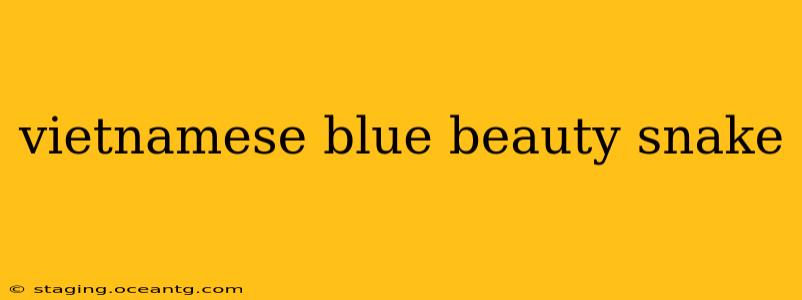The Vietnamese Blue Beauty Snake, scientifically known as Calliophis bivirgatus, is a captivating and elusive creature that captivates herpetologists and nature enthusiasts alike. Its striking blue coloration, coupled with its relatively secretive nature, makes it a subject of much fascination and ongoing research. This comprehensive guide delves into the various aspects of this mesmerizing serpent, exploring its habitat, behavior, venom, and conservation status.
What is the Vietnamese Blue Beauty Snake?
The Vietnamese Blue Beauty Snake isn't actually a distinct species, but rather a common name often used to refer to specimens of Calliophis bivirgatus found in Vietnam. Calliophis bivirgatus is a species complex, meaning it encompasses a range of geographically distinct populations with varying coloration and patterns. While the vibrant blue is prominent in many Vietnamese populations, other populations across its range (which extends across Southeast Asia) exhibit different hues. These variations often lead to different common names being applied within the hobbyist and broader communities. This beautiful snake is a member of the Elapidae family, which also includes cobras and coral snakes, immediately highlighting the importance of treating it with caution.
What is the habitat of the Vietnamese Blue Beauty Snake?
The Vietnamese Blue Beauty Snake, like other members of the Calliophis bivirgatus complex, prefers humid tropical and subtropical forests. They are often found in areas with high leaf litter and decaying organic matter, providing ample hiding places and hunting grounds. They are predominantly terrestrial, spending most of their time on the forest floor. Precise habitat preferences can vary depending on the specific subspecies or population under consideration.
Is the Vietnamese Blue Beauty Snake Venomous?
Yes, the Vietnamese Blue Beauty Snake is venomous. All members of the Calliophis bivirgatus complex possess potent neurotoxic venom. However, despite its toxicity, bites from this species are rarely reported, primarily because of its secretive nature and the snake's tendency to avoid human contact. While envenomation is rare, it's crucial to respect the snake's venomous nature and avoid handling it.
What does the Vietnamese Blue Beauty Snake eat?
The Vietnamese Blue Beauty Snake is a specialist predator, primarily feeding on other snakes and occasionally lizards. Its diet predominantly consists of smaller, burrowing snakes, which it hunts using its keen senses and rapid strikes. The exact prey species vary depending on local availability.
How big does the Vietnamese Blue Beauty Snake get?
The Vietnamese Blue Beauty Snake typically reaches a length between 40 and 70 centimeters (approximately 16 to 28 inches). Size variations exist, depending on factors like sex and geographical location. Females tend to be slightly larger than males.
What are the conservation concerns for the Vietnamese Blue Beauty Snake?
The conservation status of the Vietnamese Blue Beauty Snake, like many other species, is somewhat uncertain due to limited research. Habitat loss due to deforestation and agriculture poses a significant threat. However, specific data regarding population numbers and threats is limited. Further research is needed to assess the conservation status accurately and implement effective protection strategies.
Where can I see a Vietnamese Blue Beauty Snake?
Observing a Vietnamese Blue Beauty Snake in its natural habitat requires careful planning and a keen eye. Visiting protected areas and national parks within Vietnam that maintain suitable forest habitats would increase your chances. However, remember responsible wildlife viewing practices; never try to handle or disturb the snake.
Conclusion: A Jewel of the Vietnamese Rainforest
The Vietnamese Blue Beauty Snake, a mesmerizing creature of the Southeast Asian rainforests, remains a captivating subject for further study. Its beautiful coloration and elusive nature contribute to its allure. However, responsible stewardship and conservation efforts are vital to ensure its continued existence in its natural habitat. By understanding its ecology and the threats it faces, we can work towards protecting this valuable part of Vietnam's biodiversity.
